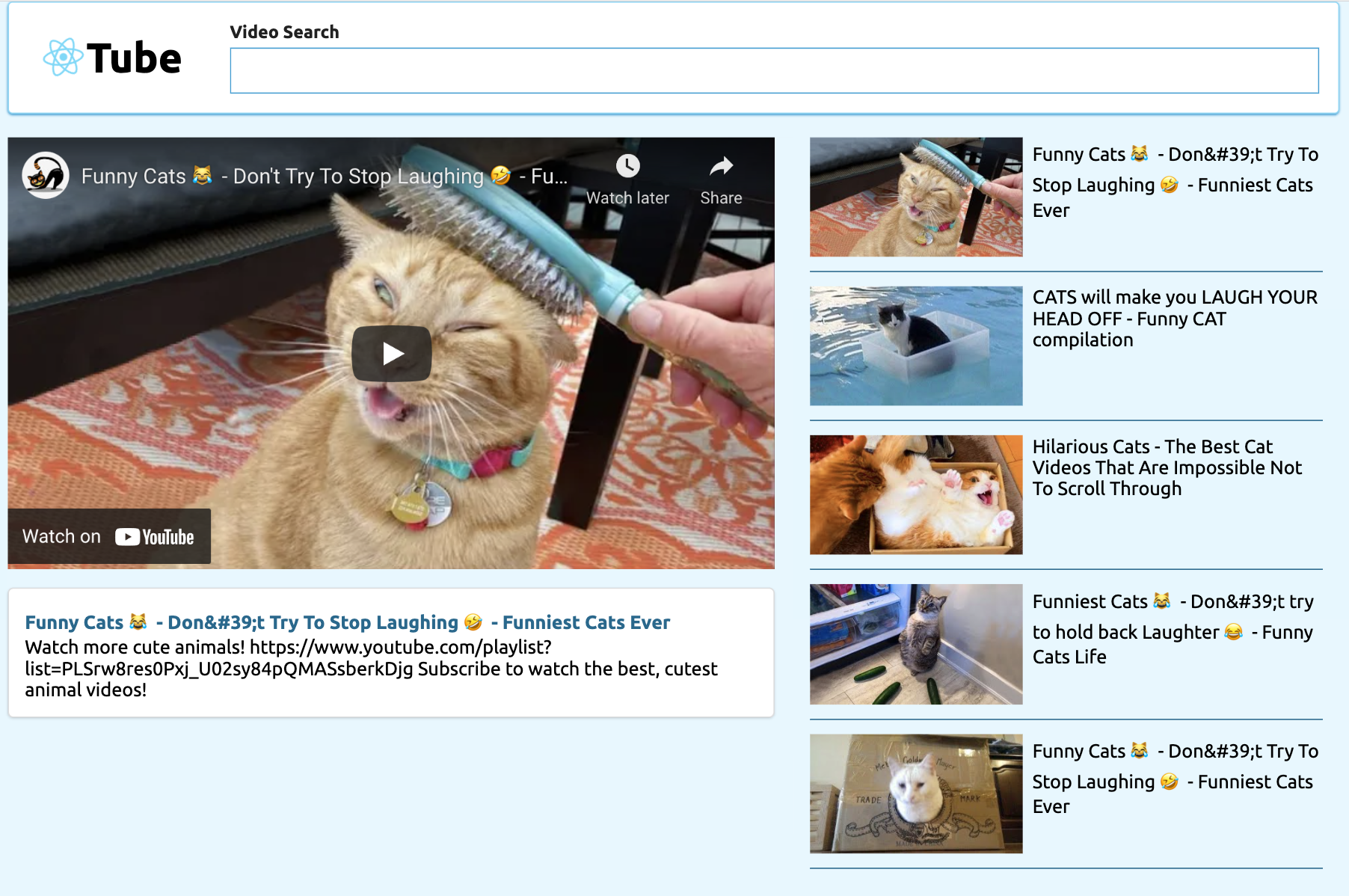Link to React Tube App
This application is built in React to search the YouTube API and return a short list of 5 videos, utilizing Primitive Hooks & Custom Hooks to fetch data.
The first video shows up in preview in the VideoDetail Component, and the full list is selectable as thumbnails to the side of the main video preview in the VideoList Component.
I've used two Primitive Hooks in this application, and here's how they were used:
- useState()
I used useState() to handle the state of the SearchBar Component input, to track the term that's being entered in the form to search the YouTube API.
const SearchBar = ({ onFormSubmit }) => {
const [term, setTerm] = useState('')
const onSubmit = event => {
event.preventDefault();
onFormSubmit(term);
};Here's the form & input JSX in the return statement of the SearchBar Component function:
<form onSubmit={onSubmit} className='form'>
<div className='field'>
<label>Video Search</label>
<input
type='text'
value={term}
onChange={(event) => setTerm(event.target.value)}
/>
</div>
</form>When the input field changes, the term state is updated as well.
- useState()
- useEffect()
I also used useState() in the App Component function to handle storing the array of videos sent back from the YouTube API, along with tracking the currently selected video in the VideoDetail Component.
const [selectedVideo, setSelectedVideo] = useState(null);
const [videos, search] = useVideos('react js');useVideos() is a Custom Hook that I wrote, to handle fetching videos.
By using the Primitive Hooks, useState & useEffect, I wrote a hook that allows us to not only set the default term of the API query by passing in an argument, but also passing in new search terms when another request is made. This makes the custom hook reusable whenever a list of videos are needed from an API.
It's handy to create custom hooks when fetching data. This happens frequently in apps of a larger scale, so I placed useVideos in the /hooks directory.
const useVideos = (defaultSearchTerm) => {
const [videos, setVideos] = useState([]);
useEffect(() => {
search(defaultSearchTerm);
}, [defaultSearchTerm]);
const search = async term => {
// the youtube function is imported from the /api folder
const response = await youtube.get('/search', {
params: {
q: term,
part: 'snippet',
maxResults: 5,
type: 'video',
key: process.env.REACT_APP_KEY,
},
});
setVideos(response.data.items);
};
return [videos, search];
};useEffect() is a Lifecycle Hook that is called when the App Component mounts initially. It submits the default search term we passed as an argument into useVideos as the search term to make an API request.
This project was bootstrapped with Create React App.
In the project directory, you can run:
Runs the app in the development mode.
Open http://localhost:3000 to view it in the browser.
The page will reload if you make edits.
You will also see any lint errors in the console.
Launches the test runner in the interactive watch mode.
See the section about running tests for more information.
Builds the app for production to the build folder.
It correctly bundles React in production mode and optimizes the build for the best performance.
The build is minified and the filenames include the hashes.
Your app is ready to be deployed!
See the section about deployment for more information.
Note: this is a one-way operation. Once you eject, you can’t go back!
If you aren’t satisfied with the build tool and configuration choices, you can eject at any time. This command will remove the single build dependency from your project.
Instead, it will copy all the configuration files and the transitive dependencies (webpack, Babel, ESLint, etc) right into your project so you have full control over them. All of the commands except eject will still work, but they will point to the copied scripts so you can tweak them. At this point you’re on your own.
You don’t have to ever use eject. The curated feature set is suitable for small and middle deployments, and you shouldn’t feel obligated to use this feature. However we understand that this tool wouldn’t be useful if you couldn’t customize it when you are ready for it.
